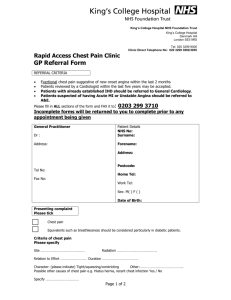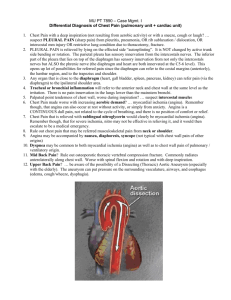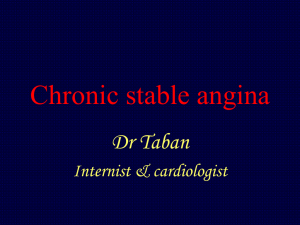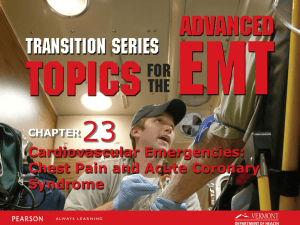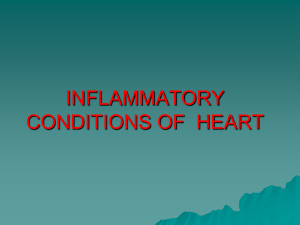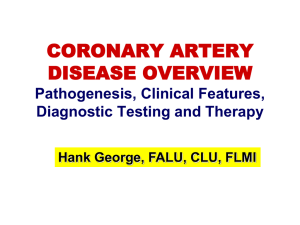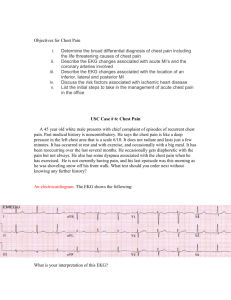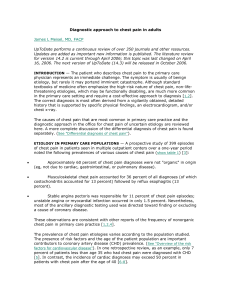Early Heart Attack Care
advertisement
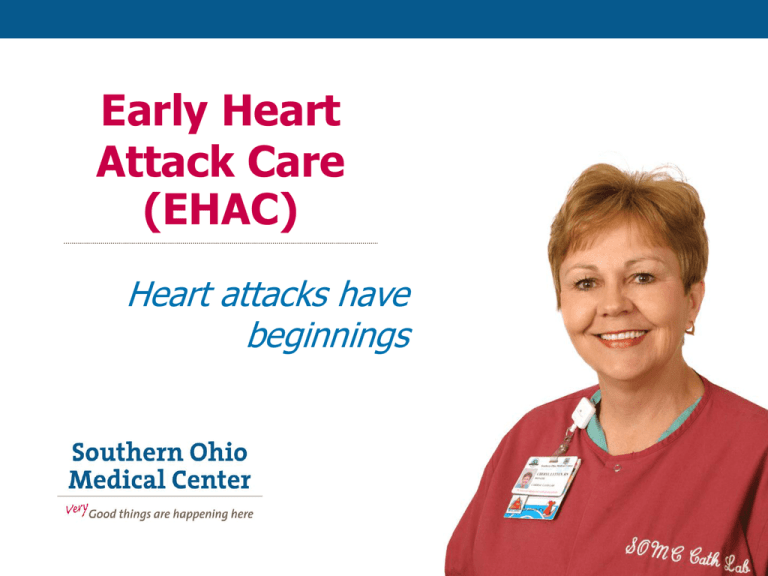
Early Heart Attack Care (EHAC) Heart attacks have beginnings Course Outline 1. Anatomy and Physiology 101: Your Heart 2. A Heart Attack in Progress 3. Concepts of Early Heart Attack Care 4. Recognition and Intervention 5. Delay and Denial 6. You: The Early Heart Attack Care Giver Part 1 Anatomy and Physiology 101: Your Heart The Human Heart • • • • • • The primary function of the heart is to pump oxygen-rich blood throughout the body. The oxygen is used by the body's tissues to perform their normal work. Your heart is approximately the same size as your fist. Inside, the heart is divided into right and left sides by a thick muscular wall called a septum. The right and left sides are divided into upper chambers called the atria and lower chambers called the ventricles. The heart's right side (consisting of an atrium and a ventricle) receives blood from the body and sends the blood to the lungs where it is replenished with oxygen. After leaving the lungs, the blood travels into the left atrium and then through the left ventricle where it is pumped out to the rest of the body. A healthy heart will beat approximately 100,000 times each day and pump over 1,800 gallons of blood throughout the body's circulatory system. The Human Heart Electric Pump • • SA Node AV Node • • • The heart has its own built-in electrical system which causes the heart to beat. In a healthy heart, each heartbeat begins in the sinoatrial node or SA node (the heart's natural pacemaker), which is located in the top right chamber of the heart (right atrium). The electrical signal starts a reaction that spreads out across both of the top chambers of the heart causing them to contract and pump blood into the lower heart chambers. The electrical impulse then spreads to the atrivoventricual node (AV Node) which is located between the atria and ventricles. The AV node slows the impulse allowing the atrium to finish contracting. From the AV Node the impulse travels to the left and right sides of the ventricles stimulating them to contract causing blood to be pumped from the R ventricle to the lungs and from the L ventricle to the rest of the body. The Human Heart and Coronary Arteries Part 2 A Heart Attack in Progress Coronary Artery Disease Coronary artery disease (CAD) is a condition in which plaque builds up inside the coronary arteries. CAD is the most common form of heart disease. CAD can lead to serious health issues such as angina and heart attack. Ischemia & Angina Pectoris When your coronary arteries are narrowed or blocked, oxygen-rich blood can't reach your heart muscle. This can cause ischemia, angina or a heart attack. Ischemia is simply an inadequate blood supply to an area. Angina is chest pain or discomfort that occurs when not enough oxygen-rich blood is flowing to an area of your heart muscle. Angina may feel like pressure or squeezing in your chest. What is a Heart Attack? A heart attack also know as an acute myocardial infarct (AMI) occurs when blood flow to a section of heart muscle becomes blocked. If the flow of blood isn’t restored quickly, the section of heart muscle becomes damaged from lack of oxygen and begins to die. This blockage may be caused by a blood clot that gets stuck in an artery or by a thickening inside the wall of an artery that restricts the flow of blood enough to cause pain and damage. Heart Attack Facts • Heart Attack is the #1 Killer of adults • 4,100 Heart attacks occur every day • 600,000 Heart attack deaths occur each year • Hundreds of thousands survive heart attacks but are left with a damaged heart Presentations of a Heart Attack • Sudden, severe pain that stops you in your tracks • Gradual increasing pain with damage occurring over a period of hours • Very early presentation with mild symptoms over hours or days Part 3 Concepts of Early Heart Attack Care (EHAC) Are All Heart Attacks Created Equal? Heart Attack Treatment • Thrombolytic Therapy (Clot Busters) – Thrombolytic Therapy is the use of drugs to dissolve clots which are blocking blood vessels. • Angioplasty – Angioplasty is a procedure that is intended to improve blood flow to your heart muscle. During angioplasty, a catheter with a balloon at the tip is placed into the narrowed blood vessel. The balloon is used to open the narrowed blood vessel and increase the blood flow to your heart muscle. • Pre-hospital Cardiac Care – Pre-hospital Cardiac Care involves providing EMT’s and Paramedics with specific treatment guidelines for potential heart attack patients prior to their arrival to the hospital. A decrease in hospital time to treatment means saved heart muscle improvement in quality of life. Too Little Progress: Heart Attack Recognition Most heart attack patients do not benefit from optimal medical advances………………………Why? Delay Answer: A delay in recognizing and responding to the early warning signs of a heart attack. Why Early Heart Attack Care? • Early Care: Recognize & Respond – Often mild symptoms, usually normal activity • Late Care: Obvious Emergency & Respond – Incapacitating pain, diminished activity • Too Late Care: Critical Emergency & Respond – Unconscious, CPR, defibrillation, probable death • 85% of the heart damage takes place within the first two hours Part 4 Recognition and Intervention Early Symptoms of a Heart Attack Non-Specific Heart Attack Symptoms • • • • • • • • Weakness/Fatigue Clammy/Sweating Nausea/Indigestion Dizziness/Nervousness Shortness of Breath Neck/Back/Jaw Pain Feeling of Doom Elbow Pain Specific Heart Attack Symptoms • • • • • Chest Chest Chest Chest Chest Discomfort Pressure Ache Burn Fullness Early Signs of Heart Attack • Early warning signs are present in up to half of heart attacks • Signs suddenly accelerate or worsen preceding the heart attack • Usually appear within 24 hours before the acute attack but can begin two to three weeks before • The duration varies from a few minutes to several hours • Usually intermittent with a pain free period before the onset of acute occlusion (blockage) Part 5 Delay and Denial Why Do We Delay? It’s nothing really serious (I’ll just rest a bit) I’m too busy right now (I don’t have time to be sick) I don’t want to be a problem (If it turns out to be nothing, I’ll be embarrassed by the fuss made) Paramedics Beware (First responders can easily be swayed by patient rationalizations and denials) It’s probably heart burn or indigestion (I’ll take something for it) I’m strong (Just walk it off, grin and bear it) I’m healthy (I have no serious medical problems… I exercise) I’ll just wait it out (Everything will be okay) Denial and Procrastination = Our Heart’s Enemy Part 6 You: The Early Heart Attack Care Giver What To Ask and Look For • Do you have any chest discomfort? • Is it tightness, pressure, pain in the center of your chest? • Is the discomfort also in your arms or jaw or neck or throat or back? • Are you sick to your stomach? • Is the person sweaty or clammy? • What were you doing when the symptoms started? • Do the symptoms go away with rest? • Are you having any shortness of breath? Listen to Your Heart and Be A Winner! • Be aware of pressure, not necessarily pain, in your chest • Be aware if it increases with activity and subsides with rest • Don’t try to rationalize it away; be honest with yourself and others • Call 911 or have someone drive you to the nearest emergency room • Don’t go to your doctor’s office or wait for an appointment • EHAC is knowing the subtle danger signs and acting on them before damage occurs Any questions? If you have further questions please contact Heart and Vascular Services. www.somc.org Safety Quality Service Relationships Performance
